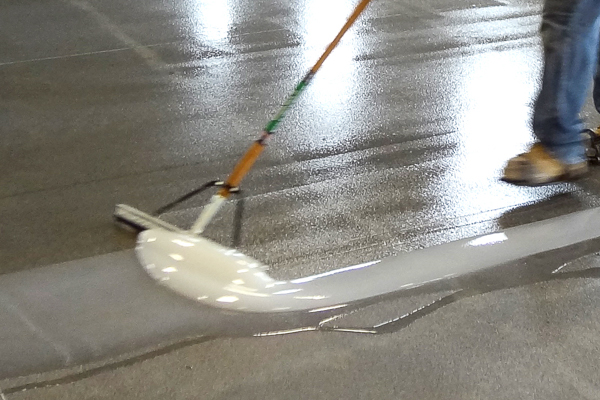Which is the best primer for concrete coatings? The answer lies in the moisture content found in the floor you are about to coat.
Here are some basics about moisture in concrete, how to test for moisture, and when to use which type of product to mitigate the moisture a moisture problem prior to installing the best resinous coating system for your concrete floor.
Moisture Comes from Below
No matter how old or beaten up, all concrete slabs are like sponges and they will absorb moisture whenever it is present. Once in the concrete, moisture in a wet slab wants to find the easiest way out, and that may be straight through the top. That can cause big problems if there is a coating present. The result could come in the form of bubbles and/or delamination of the coating system.
Moisture in concrete floors can come from multiple areas. Most of time, even in dry climates like those in the desert Southwest, we see it coming from ground water making its way into the soil where there is no vapor barrier under the slab, or where the vapor barrier was damaged. There can also be problems where a broken pipe under a slab even if it leaked some time ago, or where downspouts route rainwater downhill and under the slab.
Measuring Moisture
So how do you determine just how much moisture is in the concrete slab? There are two generally accepted methods to test for moisture and vapor pressure. The first checks just the moisture content of the concrete and is an RH test per ASTM F-2170. Wagner Meters offers equipment to perform this test, and their website offers significant information about moisture in concrete. Any reading above 75% requires a product that can withstand significant moisture, such as CFI’s WearCOAT 1080 Moisture Mitigating Primer where there is improved adhesion and moisture tolerance because of a strong chemical bond to the concrete.
The other test is a calcium chloride test that measures the vapor transmission over a period of time and provides a moisture vapor pressure number per 24 hours as defined in ASTM F-1869. Test kits and more information on this test method are available here. Any reading above 3 lbs. per 24 hours requires a product that can withstand significant moisture. Above that reading, we again recommend CFI’s WearCOAT 1080 Moisture Mitigating Primer which is rated to up to 16 lbs.
When to Use a Moisture-Mitigating Primer
A standard water-based epoxy primer such as WearCOAT 1020 does an excellent job as an everyday workhorse when it comes to concrete floor primers. But if…
1. Relative Humidity of the slab is above 75% per ASTM F-2170,
Or…
2. Moisture Vapor Pressure is greater than 3 pounds per 24 hours per ASTM F-1869
… you will need a moisture mitigating product such as WearCOAT 1080.
No matter what primer or first coat product you choose, you’ll want to be sure to properly prepare the surface prior to applying any coatings.
For help selecting the right primer click here or Contact Customer Support. We are always ready to help you choose the best concrete coating system to meet your job’s performance needs.

